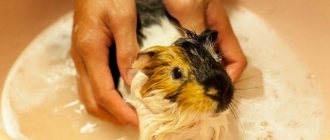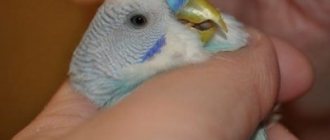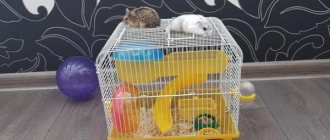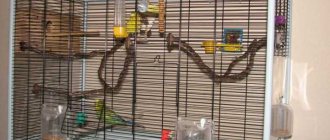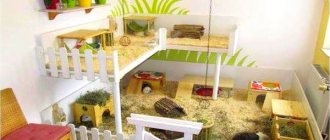A hamster's cage is not only a place to keep him, for him it is the whole world, the house where he lives. As in any home, the cage must be tidy, clean, comfortable and dry.
Reference. The hamster is a clean rodent that is not prone to living in dirt. If you do not clean your animal's house, this can lead to the development of various diseases, so do not be lazy and clean the cage regularly.
How often do you need to clean a hamster's cage and how to do it correctly?
Hamsters are clean animals.
Cleaning an animal's home is an important part of pet care. A dirty and untidy cage can cause illness in a little fidget . When the owner wants to surround the pet with care and love, he keeps the animal’s house in perfect order.
Every cleaning in a hamster’s cage is a shock for the animal, because they are used to making things cozy in their own way. How to get rid of the smell of a hamster in a cage without harming it?
Khrumik.ru - from all diseases a hamster is better off... cleanliness?
Yes, a lot in your pet’s life depends on the cleanliness of your home. After all, many hamster diseases begin with gaps in hygiene. For example, how often should the cage be washed and how exactly?
First of all, let's face it: stress is also the main cause of illness in hamsters. Therefore, too often disturbing the usual way of life, the usual mess and especially his favorite smell in the hamster’s possessions is a great experience for him.
How often should you clean a rodent's house?
An important question is how often you need to clean your hamster’s cage and remove old food and waste from his house. Let's answer it right now.
The cage is washed with soda solution 2-3 times a month . The litter changes as it becomes dirty and produces an unpleasant odor. When cleaning your hamster's house, you shouldn't completely throw out the old litter and put in a new one. Without the presence of familiar odors, the animal can become disoriented.
If the home is equipped with labyrinths, tunnels and houses, then you need to make sure that leftover food does not accumulate in them, which the hamster hides in reserve. Cleaning a hamster cage with pipes is carried out according to the same algorithm. It is also necessary to wipe all items from dust and dirt.
Horizontal connection
Does the space in your apartment allow you to place 2 cells side by side? Then they can be united by fancy tunnels. And if the hamster cottages are also multi-tiered, then it becomes possible to arrange a real amusement park for hamsters!
For this you will need:
- pipes for creating labyrinths, straight or curved;
- adapters from pipes to a square entrance (if the doors are not round);
- insulating tape;
- scissors.
Connect the pipes using special fasteners, giving the tunnel an interesting shape. Try on the tunnels before securing them. The pipes must be securely attached to the entrances. Particular attention should be paid to ensuring that there are no gaps through which the hamster could escape. To do this, you will need adapters, which are sold in pet stores. For greater reliability, the connections should be reinforced with electrical tape.
You can make several labyrinths through which you can get from one cell to another. This will be much more interesting for the fluffies. But please note that at the end of the tunnel there must be a surface on which the pet could stand, and not flop straight to the bottom of its home.
The result will be a design like this:
Some owners go further and combine the two described ideas in one project. That is, first they put several hamster houses on top of each other in 2 columns, and they get two combined cottages. And then they make a horizontal connection using pipes. It also turns out quite original.
Cleaning tools
If you start cleaning the cage, then you need to do it carefully. It is important to follow the order of actions. Inspect the room where the pet lives. This is necessary to assess the scale of the work and identify the dirtiest corners. Poor cleaning, which leaves behind dirt, provokes the appearance of pathogenic microbes . Without waiting for general cleaning, clean the following daily:
- The animal's toilet area. Here the litter gets wet more than at other points, and droppings also accumulate.
- Uneaten remains of food that the animal scatters around the cage.
- The water needs to be replaced every day. The bedding on which the drink falls is removed and freshly laid.
Dirty walls are the culprits of the unpleasant odor that the cage emits. In this case, you will have to clean the entire space of the house.
The preparatory stage is no less important. It consists of selecting equipment and cleaning products that will be needed for the job. This must be done so that during the process you are not distracted by searching for the right tool. To work you will need:
- A cloth for wiping the cage and internal accessories.
- Detergent or soap that does not contain aggressive substances such as bleach. Such components can cause irreparable harm to a little furry. It is better if you buy a product designed for washing cells in a specialized store .
- Clean filler to replace the old one.
Before harvesting, the animal will have to be transplanted to another safe place. High-quality cleaning of the cage is possible only without its occupant.
Stages of cage cleaning
Now let’s look in more detail at how to clean a hamster’s cage. As already mentioned, before starting work, transfer the hamster. Choose a clean box or container where he won't escape.
You can use the ball for a walk. In this case, you need to do the cleaning quickly, it is advisable not to delay it for more than half an hour. Otherwise, the animal will get tired and nervous. Next, do the following:
- Remove all items from the house: cups, toys, structures. The contents must be washed thoroughly and dried well with a clean rag or towel.
- Remove the filler.
- Treat the house well from all sides.
- Add fresh bedding.
In addition to the main filler, leave a few clean paper napkins for the animal. They will be useful for your pet to make his home comfortable after your intervention.
You shouldn’t wait until you notice an unpleasant smell coming from the house. If cleaning is done infrequently, the cage can become unsanitary, and a stale smell makes the hamster feel discomfort and can cause viral diseases.
To achieve the best result, you need to restore order using a solution of water and washing liquids. Dishwashing detergents or laundry soap are suitable for the job. Particularly caring owners prefer simple table vinegar to chemical compounds . You can soak individual elements inside the cage in it. You need to leave parts of the house in the solution for 30 minutes, after which you carefully clean off any remaining dirt with a special scraper.
Connecting hamster houses
When combining cells into one house, the location of the doors is of great importance. If apartments have several entrances, this is very convenient; you can combine them in any way. The most common connections are:
- Vertical. One house is placed on top of another, resulting in a two-story cottage (if both squares were single-tiered). The floors are connected by stairs. This is the simplest option for cells that have only an upper entrance.
- Horizontal. The cells stand side by side and are connected through tunnels. A particularly chic design is obtained by combining two multi-tiered cells.
If you have a lot of free time and a lot of plastic bottles, you can build a diagonal connection of several houses. But first, practice on simpler options.
Vertical connection
The easiest option, which will require a minimum amount of materials, namely:
- 2 one-story cells;
- wire or special clamps;
- metal scissors.
Using this method, you can combine 2 identical small cells into a large two-tier one. But an even more interesting option is to connect rooms of different lengths, then you will get a house with an attic!
Making such a design is a simple matter:
- Place the large cage on the floor and open the top entrance.
- Remove the tray from the small cage and put it away (you only need a metal frame).
- Place the small wire box directly above the top entrance to the large one.
- Connect them in this position in several places using special clamps or wire (use metal scissors to cut the wire).
- Make a ladder or slide leading from the first floor to the second.
Well, now you can add a few interior items (shelter, bowl, running wheel, etc.) - and a cozy house with an attic is ready!
Cleaning a rodent's home after birth
There's a new addition to the house, but the owner doesn't know when to clean the cage after giving birth to a hamster? This also happens.
It is necessary to clean the house after giving birth, after two weeks. While putting things in order, the mother and babies are left inside the home, trying not to disturb them, or they are carefully moved to another place.
They remove the cage in the same way as before, only observing one rule: touching the young offspring with your hands is prohibited . It is important to remember this so that the human smell does not remain on the babies. If this is not done, the mother may abandon her cubs. It happened that a hamster ate the offspring that a person touched.
Recommendations for cleaning a cage with newborns:
- Wear disposable gloves.
- Taking the offspring by the scruff of the neck, as animals carry their children, carefully move them to a safe place.
- Send mom after the kids.
- Clean the cage in the usual way.
- Putting on gloves, we return the offspring together with the parent to its place.
If you can move the babies with the bedding on which they were lying, then it is best to do so. This procedure will preserve the smell to which hamsters are accustomed.
By learning how to properly clean your furry friend's cage, strictly following the cleaning algorithm, you will ensure cleanliness and order for your hamster, making your baby happier. Maintaining the home in a hygienic condition will provide the rodent with good health , and will save the owner from unnecessary problems and worries.
Don’t forget to keep an eye on the food that the thrifty animal hides in all corners of its shelter. Remember that the drinking bowl is filled as often as the animal requires.
Rules for arranging a home for a hamster
What can you use to make a home for a Syrian hamster?
If it is not possible to purchase a cage, you can make it yourself. The following designs are possible:
- A good solution would be a food container. Using it, you don’t have to worry about your pet chewing through the walls. There will also be no problems with ventilation.
- The mink is made by analogy with the animal’s natural home. The disadvantage of such a home is that it is poorly ventilated.
- You can use an aquarium. Its advantage is that the sawdust will not fly in different directions and the animal will not be able to easily get out, but the aquarium is not ventilated enough, which is a disadvantage.
- From a ventilation point of view, the most optimal solution is lattice cages.
Features of cleaning after childbirth
The birth of a female hamster, especially the first one experienced by the owner of the animal, can cause some difficulties for its owner. Don’t be scared, nothing bad happened, but you should know how to behave in such a situation.
First of all, it must be said that childbirth is a natural process characteristic of all animals, hamsters are no exception. At first they should not be disturbed; the cage can be removed no earlier than after 1.5–2 weeks. The mother and babies need to be carefully transplanted into a box with soft bedding.
The cage is cleaned in the same way as in a normal situation; the sequence of actions, means and materials are the same. The only difference is the movement of the inhabitants of the home.
Important! When transferring hamsters to another place, keep in mind: under no circumstances should you touch the babies with your bare hands. If human odor remains on them, the mother may abandon the offspring or even eat them
This should be done this way:
- Put on new rubber gloves.
- Gently grab the baby by the scruff of the neck (this is how animals themselves do this with their offspring), transfer him to a box or container.
- Place the mother near the babies.
- Clean the cage and wash it.
- Wearing gloves, move the animals back to their permanent home.
Keeping your hamster's cage clean and properly caring for it is a necessary condition for your pet to grow healthy and delight you with its kind, cheerful disposition. In addition, by observing hygiene standards, as a bonus, you will receive the absence of any noticeable odor characteristic of these rodents.
Cleaning the hamster's cage
Cleaning the cage is an important part of caring for your hamster. The health of the pet depends on this. On the one hand, you need to clean often to always maintain cleanliness and order. This way there will be less chance of catching some disease. But every cleaning is stressful and even stressful for the hamster. He put everything in its place, his smell is everywhere. But here, in a short time, everything is different, the smell has practically disappeared, there has been a rearrangement inside, some of the supplies have disappeared somewhere. This situation is also harmful. So we need to find a middle ground? How to clean a hamster's cage?
Cleaning is done every 2-4 weeks. Before you begin, you must know the structure of your home. Like in humans, its cell is divided into unique zones. In one corner there is a toilet, in another there is a gym, and there he has a house for sleeping. Pay special attention to the pantry. There the pet stores all its reserves. Destroying them means dooming the fluffy to serious stress. It's like an apartment robbery for us. Therefore, when cleaning the cage, only spoiled food should be removed. In the case of several rodents in one cage, try not to mix their supplies.
Why does a hamster bite
Hamsters, including domestic ones, are primarily rodents. It is in the hamster's genes to bite any object that catches its eye. Hamster teeth grow quickly and need to be ground down using twigs, roots or mineral stone.
In the absence of this, the animal gnaws on everything, including the owner’s hands. You are picking up the hamster incorrectly - it is preferable to place your hand so that the pet can climb on it, or take it from the side, if you take the rodent from above, it will get scared and may bite. Your hands smell like food - be sure to wash your hands thoroughly before handling your pet.
The rodent studies the surrounding space, testing everything to its teeth - in this case, the main thing is not to scare the pet with your scream and switch its attention to another object. The animal is experiencing stress (for example, a change of place of residence) - if possible, eliminate the causes of stress; if this is a move, do not touch the hamster for several days, avoiding cleaning the cage. Pregnant and lactating females may show aggression instinctively in order to protect the offspring - this will pass when the young grow up. During this period, you should not try to pick up the animal.
You can train your hamster to stop biting at home in several stages.
- Use of treats. We take nuts or seeds in our hands and smoothly insert our hand into the cage. The hamster will smell the food and move closer to your hand. At first, we leave the treats in the feeder while the animal gets used to the sight of the hand and the smell.
- When the pet becomes bolder, we wait for him to try to climb onto your hand with a treat. For some time you will need to let him stomp on your palm and eat the treat.
- When this stage has been passed, you can lightly stroke the animal’s back. But under no circumstances touch your head.
- After getting used to all of the above actions, you can try to pull the hamster sitting in the palm of your hand out of the cage and pick it up.
It is important to do everything slowly and carefully, with a lot of patience. Always approach the cage in such a way that the rodent can see you. Attempts to take him from behind will lead to aggression and repeated bites.
Second weaning method
There is another way. Using a scoop or similar object, you need to remove the hamster from the cage and place it on the bed or floor - any flat surface. First, let the animal walk around on its own so that it can sniff everything and feel safe.
Note! Before releasing the rodent from the cage, prepare an area for it in advance, fence it off on all sides so that the hamster does not escape. Finding and catching a rodent in an apartment is quite difficult! After a while, block the rodent's path with the back of your hand
The outer part of the palm will look more like a regular barrier, while the inner side will frighten the animal. A rodent may associate splayed fingers with the fangs of a predator - this is an instinctive reaction
After a while, block the rodent's path with the back of your hand. The outer part of the palm will look more like a regular barrier, while the inner side will frighten the animal. A rodent may associate splayed fingers with the fangs of a predator - this is an instinctive reaction.
Once the hamster decides to bite you, blow on it slowly and evenly. He won't like air directed at his muzzle. After this, move the rodent back to the cage and repeat the lesson the next day. After a few days of training, the pet will develop a reflex: an attempt to bite the owner’s hand causes an unpleasant wind. Then the animal will understand that it is better not to bite.
Both methods may not bear fruit immediately. And you need to choose an approach to a specific animal.
Where to start cleaning your home
The first thing to do is remove the animal itself. During this time, it can be kept in another cage or carrier; some use a regular jar. First, we change the pallet with bedding. It is important not to touch anything that was constructed by the animal. He put a lot of time and effort into each design. Try to minimize your direct interference in his life. How to clean a hamster cage? The pan must be washed with plenty of waste water. If the contamination is serious and this method does not work, you need to take a special hamster shampoo or baby detergent. Whether an allergic reaction will occur depends on what you wash the hamster's cage with, since chemicals are contraindicated for rodents. In children's products, its amount is kept to a minimum. Ideally, of course, you need to wash everything manually; we use additional products only in case of serious contamination. For preventative purposes, you can additionally disinfect your home. How to clean a hamster cage? As well as other utensils, such as a razor. Girls will understand me. The only caveat is that it does not use detergents. Now he is replacing the old bedding with a new one. It is important to not change all of it, we leave some of the old one so that the smell of the hamster does not completely disappear from the home. It is important to know how to stop a hamster from biting so as not to be attacked.
How to decorate a rodent's home for the holidays?
To feel the New Year's mood, the places where pets live are also decorated. Cages with pallets on the outside around the perimeter can be decorated with tinsel. To do this, in some places it needs to be fixed with tape. Then they hang the toys outside the pet’s home. On the outside of the drinking bowl there are areas inaccessible to the hamster, which are decorated with snowflakes or balls.
Decorating your hamster's cage before Valentine's Day is also fun. Its outer part is covered with red or crimson hearts. It’s great if an aquarium is reserved for the animal’s home. Decorating it from the outside is much safer than decorating a cage, because in this case the pet will not be able to reach them.
After you have become familiar with the nuances of arranging a hamster's home, buy the animal you like. Give him everything he needs and it will keep him healthy for years to come.
Why is it important to keep the cage clean?
By nature, hamsters are very clean. Wild relatives of domestic hamsters do everything to ensure that no foreign odors come from their homes and fur.
Interesting! Any smell is a bait for a predator, so in the process of evolution, hamsters have learned to carefully care for their fur and fur.
The possibilities of domestic hamsters are limited, at least because they do not live in burrows, but in cages. Responsibility for maintaining cleanliness and optimal living conditions rests with the owner.
Why is it important to keep your cage clean:
- Over time, the cell litter becomes damp and becomes fertile soil for the proliferation of pathogenic bacteria.
- If you do not clean it regularly, a strong, unpleasant odor will emanate from the cage and the hamster.
- Hamsters sleep buried in the bedding, so a dirty cage is a direct path to various inflammatory processes and deterioration in the quality of the coat.
- When your hamster smells bad, he is constantly stressed. The pet instinctively worries that it may become a victim of a predator.
Cleaning the cage is not the most pleasant pastime, but it is an essential aspect of caring for pet rodents. In addition, by following basic instructions, you can get rid of the unpleasant odor that comes from the litter.
How to play with a hamster?
Hamsters love to crawl through cardboard tubes (toilet paper or toilet towels) and chew wrapping bags. You can place large wooden cubes on top of each other and make a labyrinth out of them. Try offering wooden spools or tree branches for your hamster to chew on or climb on.
Interesting materials:
What is speech audiometry? What is a site redirect? What is a regular and charter flight? What is an advertising agent? What is a steering belt? What is handicraft? What is profitability? What is reposting a publication? What is a repost in like? What is a decision of the court of first instance?
Where to move a hamster during cleaning
The first question that needs to be resolved is where to move the hamster during the cleaning period. Ideally, you need to have a second, small cage in which the pet can rest without unnecessary stress.
If there is no second cell, it can be placed in:
- In a plastic container with a lid. You first need to make several holes in the lid. A closed plastic container should never be left in direct sunlight.
- Three-liter jar. A quite tolerable shelter for a hamster, based on cleaning within 30–60 minutes. Like a plastic container, the jar should not be left in the sun.
- Bath. By closing the drain hole and laying towels on the bottom of the bathroom, you can calmly start cleaning and not worry that the hamster will escape.
Important! It is not recommended to leave the hamster in a cardboard box while cleaning, as the pet can easily chew through the wall and run away.
Equipment and cleaning products
You may need equipment and cleaning products:
- Viscose napkins.
- Old toothbrush.
- A large basin in which you can soak accessories. In order for the tunnels, wheel, house and other accessories to be washed better, it is enough to hold them in a soap solution for 5-10 minutes. Wooden products should not be soaked!
- Disinfectant solution for cleaning rodent cages.
Bathing technique
A very important point: the temperature in the rooms where the cage is located and where bath procedures are carried out should be slightly higher than usual; There should be no drafts, running fans, air conditioners, etc.
We invite you to familiarize yourself with the Rottweiler dog: photo, character, description of the breed
First you need to pour warm water (30 degrees) into a bowl to the depth of 2–2.5 centimeters, no more. Then place your pet in this container near the side so that he can hold on with his paws and not fall.
But you can’t just leave him - he’ll run away, you need to control his every movement.
Take warm water into a mug or ladle and carefully, avoiding getting the liquid into the ears and eyes, pour it over the animal so that the fur gets wet.
Do not bathe your hamster in the sink, because it takes a lot of water and time to warm up - temperature changes can make the animal sick. Moreover, the sink is very slippery, so the rodent can fall and choke.
The sink is very cold and slippery, the hamster can slip and choke in the water
You can only wash the fur with foam, not with the product itself. To do this, dilute a drop of shampoo in water, whisk it and apply it to the fur, gently massaging it. Under no circumstances should you use a sponge or hard brushes.
Use only foam to wash hamsters
After the “massage” you can immediately rinse it by watering the animal from a cup or mug. Rinse off until the water is clear - small amounts of shampoo can cause skin irritation and digestive upset if ingested.
Dry your hamster first with paper towels to remove as much liquid as possible from his fur, then wrap him in a terry towel and hold him there for a few minutes.
Do not use a hairdryer to dry the animal - its little heart will not withstand such abuse.
Use towels to remove as much water as possible from your hamster's fur.
The penultimate step is to comb the coat if it is long. To do this, you can use a special comb or a soft toothbrush.
Use only soft brushes to brush your hamster's fur.
Release the hamster into the house, giving him a piece of treat in his paws. This will cheer him up and help him forget the horrors of the bathroom he experienced. Most likely, the animal will hide and will not come out for a long time - do not touch it, but put more tasty food in the cage.
After a bath, always give your hamster his favorite treat (it should also be healthy)
Frequency of cage cleaning
Before you start cleaning, look carefully at your hamster's cage. The frequency of cleaning the cage will depend on the current condition. Carefully inspect:
- Tray.
- Walls.
- All gaming accessories.
- Feeder and drinker.
Tip: If your hamster's cage looks too dirty, clean it in sections. Global, general cleaning can cause stress for your pet.
It is best to spend 10–15 minutes cleaning the cage several times a week:
- Remove wet parts of the litter. Over time, hamsters choose one place to go to the toilet. The rest of the bedding will remain relatively clean, but one of the corners of the cage will be constantly wet.
- Remove food supplies from the corners of the cage or in the house. Hamsters instinctively stock up, even if they are not in danger of starvation. You will notice that your pet is especially active in storing food in the fall.
- Wash one of the accessories in the cage thoroughly ; the next time you clean it, it will be enough to wipe it.
Important! The water in your hamster's drinking bowl must be changed daily! The drinking bowl must be washed every time the water is changed, especially in hot weather.
The need to carry out general cleaning arises if the walls of the cage are dirty or there is a persistent or unpleasant odor emanating from it.
How to prevent unpleasant odors
A few simple tricks will help reduce the time spent cleaning up after your hamster. It is impossible to do without this, of course. But every owner of these cute animals can make their life easier and remove the smell of hamsters.
Toilet training your pet
In a habitable house, the hamster usually chooses one corner (usually away from the drinking bowl and sleeping area) to relieve its natural needs. You can put a small tray with filler in this place. The first time the tray is sprinkled with already soiled filler, so as not to frighten the animal. This technique will help make the cleaning process a little easier.
It can be divided into daily and “general” - with washing the entire house, when the smell of hamsters is completely removed.
Choosing the right filler
Corn litter is best suited for hamsters, since it is the type of litter that reliably blocks the smell of urine. With him, you will only have to clean the cage once every 10–14 days. Every week you have to clean out the wood filler (shavings, sawdust, pressed pellets).
Proper cage cleaning
You shouldn’t look for the reason why hamster urine stinks; this fact should be taken for granted. The task of the animal owner is to provide him with decent living conditions.
Washing the cage, toys, drinkers and feeders, as well as the tray should not be done with chlorine bleach: even a small residue can be fatal for a tiny animal.
It is much safer to use a special shampoo for hamsters. If you clean regularly, it is not difficult to do.
During cleaning, the animal is placed in a safe place. It is best to use a jar or carrier.
Hamsters living in a cage that is regularly cleaned by their owners do not smell of anything. The appearance of such a problem indicates two main reasons: cleaning is not done often enough, or the rodent is sick. With careful care, these animals do not cause any trouble, but they delight you with an endless stream of positive emotions.
Stages of cleaning a cage
The stages of cleaning the cage are arranged depending on the volume and scale of the work. Consider the sequence of general cleaning:
- Prepare a bowl of warm soapy water.
- Fill a spray bottle with soapy water.
- Remove all accessories that need to be soaked and place in a basin.
- Remove all litter from the tray and fill it with warm water.
- Use a spray bottle and an old toothbrush to clean the joints of the cage walls.
- Wash the drinker and feeder thoroughly.
While the tray is wet, it must be treated with a disinfectant. After soaking and washing and assembling the cage, you need to wait for it to dry completely. It is better to dry the cage and accessories in the sun.
Cleaning toys and equipment
Cleaning toys and equipment is one of the most difficult tasks, as dirt gets stuck in the joints and fastenings. In addition, if toys are made of not very high-quality plastic, they can “keep an odor.” If the smell remains on the toys even after washing, they will have to be replaced.
Cleaning the walls
Cleaning walls is a long, monotonous, but fairly simple process:
- Hydration. The rods and their joints must be thoroughly sprayed with soapy water.
- Rough cleaning. Using a toothbrush, clean all joints, moving from the corners to the middle of the walls.
- Rinsing. Rinse off the soapy solution under running water or with a napkin.
- Drying. Wipe the bars and joints with a dry cloth, then leave the cage in the sun or draft for 10–20 minutes.
Over time, the paint on the rods will begin to peel off. This process cannot be “started”, otherwise the cell will begin to rust. Places where the paint has come off the rods must be sanded. To protect metal from corrosion, you can use spray paint or primer.
Tray washing
The main purpose of complete cleaning is washing the tray. Particular attention should be paid to corners, sides and wall joints. Even heavy dirt can be removed by first soaking the tray and cleaning the corners with an old toothbrush.
Cleaning the feeder and drinker
Clean the feeder and drinker only with water and a clean cloth. If the feeder is plastic, it can “hold” the smell.
From frequent washing, plastic becomes porous, as a result of which it is very difficult to wash.
Cleaning the toilet
Cleaning the toilet can be done without disassembling and completely cleaning the cage. Moreover, cleaning your toilet 3-4 times a week will make your deep cleaning process much easier.
